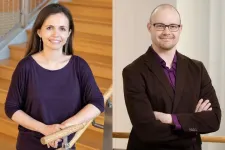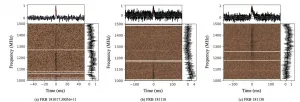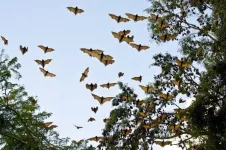INFORMATION:
This research was supported, in part, by the Simons Foundation.
Written by Jennifer Chu, MIT News Office
Paper: "On a question of Mordell"
https://www.pnas.org/content/118/11/e2022377118
After cracking the "sum of cubes" puzzle for 42, researchers discover a new solution for 3
The 21-digit solution to the decades-old problem suggests many more solutions exist.
2021-03-11
(Press-News.org) What do you do after solving the answer to life, the universe, and everything? If you're mathematicians Drew Sutherland and Andy Booker, you go for the harder problem.
In 2019, Booker, at the University of Bristol, and Sutherland, principal research scientist at MIT, were the first to find the answer to 42. The number has pop culture significance as the fictional answer to "the ultimate question of life, the universe, and everything," as Douglas Adams famously penned in his novel "The Hitchhiker's Guide to the Galaxy." The question that begets 42, at least in the novel, is frustratingly, hilariously unknown.
In mathematics, entirely by coincidence, there exists a polynomial equation for which the answer, 42, had similarly eluded mathematicians for decades. The equation x3+y3+z3=k is known as the sum of cubes problem. While seemingly straightforward, the equation becomes exponentially difficult to solve when framed as a "Diophantine equation" -- a problem that stipulates that, for any value of k, the values for x, y, and z must each be whole numbers.
When the sum of cubes equation is framed in this way, for certain values of k, the integer solutions for x, y, and z can grow to enormous numbers. The number space that mathematicians must search across for these numbers is larger still, requiring intricate and massive computations.
Over the years, mathematicians had managed through various means to solve the equation, either finding a solution or determining that a solution must not exist, for every value of k between 1 and 100 -- except for 42.
In September 2019, Booker and Sutherland, harnessing the combined power of half a million home computers around the world, for the first time found a solution to 42. The widely reported breakthrough spurred the team to tackle an even harder, and in some ways more universal problem: finding the next solution for 3.
Booker and Sutherland have now published the solutions for 42 and 3, along with several other numbers greater than 100, this week in the Proceedings of the National Academy of Sciences.
Picking up the gauntlet
The first two solutions for the equation x3+y3+z3 = 3 might be obvious to any high school algebra student, where x, y, and z can be either 1, 1, and 1, or 4, 4, and -5. Finding a third solution, however, has stumped expert number theorists for decades, and in 1953 the puzzle prompted pioneering mathematician Louis Mordell to ask the question: Is it even possible to know whether other solutions for 3 exist?
"This was sort of like Mordell throwing down the gauntlet," says Sutherland. "The interest in solving this question is not so much for the particular solution, but to better understand how hard these equations are to solve. It's a benchmark against which we can measure ourselves."
As decades went by with no new solutions for 3, many began to believe there were none to be found. But soon after finding the answer to 42, Booker and Sutherland's method, in a surprisingly short time, turned up the next solution for 3:
5699368212219623807203 + (?569936821113563493509)3 + (?472715493453327032)3 = 3
The discovery was a direct answer to Mordell's question: Yes, it is possible to find the next solution to 3, and what's more, here is that solution. And perhaps more universally, the solution, involving gigantic, 21-digit numbers that were not possible to sift out until now, suggests that there are more solutions out there, for 3, and other values of k.
"There had been some serious doubt in the mathematical and computational communities, because [Mordell's question] is very hard to test," Sutherland says. "The numbers get so big so fast. You're never going to find more than the first few solutions. But what I can say is, having found this one solution, I'm convinced there are infinitely many more out there."
A solution's twist
To find the solutions for both 42 and 3, the team started with an existing algorithm, or a twisting of the sum of cubes equation into a form they believed would be more manageable to solve:
k ? z3 = x3 + y3 = (x + y)(x2 ? xy + y2)
This approach was first proposed by mathematician Roger Heath-Brown, who conjectured that there should be infinitely many solutions for every suitable k. The team further modified the algorithm by representing x+y as a single parameter, d. They then reduced the equation by dividing both sides by d and keeping only the remainder -- an operation in mathematics termed "modulo d" -- leaving a simplified representation of the problem.
"You can now think of k as a cube root of z, modulo d," Sutherland explains. "So imagine working in a system of arithmetic where you only care about the remainder modulo d, and we're trying to compute a cube root of k."
With this sleeker version of the equation, the researchers would only need to look for values of d and z that would guarantee finding the ultimate solutions to x, y, and z, for k=3. But still, the space of numbers that they would have to search through would be infinitely large.
So, the researchers optimized the algorithm by using mathematical "sieving" techniques to dramatically cut down the space of possible solutions for d.
"This involves some fairly advanced number theory, using the structure of what we know about number fields to avoid looking in places we don't need to look," Sutherland says.
A global task
The team also developed ways to efficiently split the algorithm's search into hundreds of thousands of parallel processing streams. If the algorithm were run on just one computer, it would have taken hundreds of years to find a solution to k=3. By dividing the job into millions of smaller tasks, each independently run on a separate computer, the team could further speed up their search.
In September 2019, the researchers put their plan in play through Charity Engine, a project that can be downloaded as a free app by any personal computer, and which is designed to harness any spare home computing power to collectively solve hard mathematical problems. At the time, Charity Engine's grid comprised over 400,000 computers around the world, and Booker and Sutherland were able to run their algorithm on the network as a test of Charity Engine's new software platform.
"For each computer in the network, they are told, 'your job is to look for d's whose prime factor falls within this range, subject to some other conditions,'" Sutherland says. "And we had to figure out how to divide the job up into roughly 4 million tasks that would each take about three hours for a computer to complete."
Very quickly, the global grid returned the very first solution to k=42, and just two weeks later, the researchers confirmed they had found the third solution for k=3 -- a milestone that they marked, in part, by printing the equation on t-shirts.
The fact that a third solution to k=3 exists suggests that Heath-Brown's original conjecture was right and that there are infinitely more solutions beyond this newest one. Heath-Brown also predicts the space between solutions will grow exponentially, along with their searches. For instance, rather than the third solution's 21-digit values, the fourth solution for x, y, and z will likely involve numbers with a mind-boggling 28 digits.
"The amount of work you have to do for each new solution grows by a factor of more than 10 million, so the next solution for 3 will need 10 million times 400,000 computers to find, and there's no guarantee that's even enough," Sutherland says. "I don't know if we'll ever know the fourth solution. But I do believe it's out there."
ELSE PRESS RELEASES FROM THIS DATE:
Paper: Personal charitable donation budgets flexible in aftermath of deadly storms
2021-03-11
CHAMPAIGN, Ill. -- Charitable donations account for about 2% of gross domestic product in the U.S., but it's not well-understood whether an event such as a deadly storm inspires increases in charitable giving or simply reallocates a fixed supply of donation dollars that would have otherwise gone to another cause.
A new paper from a team of University of Illinois Urbana-Champaign experts finds that, in the aftermath of catastrophic tornadoes, charitable giving to alleviate an unanticipated event doesn't necessarily crowd out monetary donations to ...
Air pollution: The silent killer called PM2.5
2021-03-11
Millions of people die prematurely every year from diseases and cancer caused by air pollution. The first line of defence against this carnage is ambient air quality standards. Yet, according to researchers from McGill University, over half of the world's population lives without the protection of adequate air quality standards.
Air pollution varies greatly in different parts of the world. But what about the primary weapons against it? To find answers, researchers from McGill University set out to investigate global air quality standards in a study published ...
Tracking cosmic ghosts
2021-03-11
The idea was so far-fetched it seemed like science fiction: create an observatory out of a one cubic kilometer block of ice in Antarctica to track ghostly particles called neutrinos that pass through the Earth. But speaking to Benedickt Riedel, global computing manager at the IceCube Neutrino Observatory, it makes perfect sense.
"Constructing a comparable observatory anywhere else would be astronomically expensive," Riedel explained. "Antarctica ice is a great optical material and allows us to sense neutrinos as nowhere else."
Neutrinos are neutral subatomic particles with a mass close to zero that can pass through solid materials at near the speed of light, rarely reacting with normal matter. They were first detected in the 1950s in experiments that operated ...
Distant planet may be on its second atmosphere, NASA's Hubble finds
2021-03-11
Scientists using NASA's Hubble Space Telescope have found evidence that a planet orbiting a distant star may have lost its atmosphere but gained a second one through volcanic activity.
The planet, GJ 1132 b, is hypothesized to have begun as a gaseous world with a thick hydrogen blanket of atmosphere. Starting out at several times the diameter of Earth, this so-called "sub-Neptune" is believed to have quickly lost its primordial hydrogen and helium atmosphere due to the intense radiation of the hot, young star it orbits. In a short period of time, such a planet would be stripped down to a bare core about the size of Earth. That's when things got interesting.
To the surprise of astronomers, Hubble observed an ...
Messenger RNA COVID-19 vaccines greatly reduce risk of asymptomatic COVID-19 infection, spread to ot
2021-03-11
ROCHESTER, Minn. -- Ten days after receiving a second dose of a messenger RNA, or mRNA, vaccine for COVID-19, patients without COVID-19 symptoms are far less likely to test positive and unknowingly spread COVID-19, compared to patients who have not been vaccinated for COVID-19. The Pfizer-BioNTech and Moderna messenger RNA vaccines for COVID-19 are authorized for emergency use in the U.S.
With two doses of a messenger RNA COVID-19 vaccine, people with no symptoms showed an 80% lower adjusted risk of testing positive for COVID-19 after their last dose. Those are the findings of a Mayo Clinic study of vaccinated patients. These finding appear in the journal Clinical Infectious Diseases.
The authors say these findings underscore ...
Breast feeding mothers do not transfer COVID through milk
2021-03-11
A study conducted by researchers at the University of Rochester Medical Center (URMC) - in collaboration with several other universities - indicates that breastfeeding women with COVID-19 do not transmit the SARS-CoV-2 virus through their milk, but do confer milk-borne antibodies that are able to neutralize the virus.
The study, "Characterization of SARS-CoV-2 RNA, antibodies, and neutralizing capacity in milk produced by women with COVID-19," published on February 9 in the journal mBio - analyzed 37 milk samples submitted by 18 women diagnosed with COVID-19. None of the milk samples were found to contain ...
FAST captures distant fast radio bursts from the youth of universe
2021-03-11
Fast radio burst (FRB) is a kind of mysterious radio flashes lasting only a few thousandths of a second. Confirmed to be the cosmological origin in 2016, FRB has the potential to provide insights into a wide range of astrophysical problems.
Dr. NIU Chenhui from the team led by Dr. LI Di and Dr. ZHU Weiwei from National Astronomical Observatories of Chinese Academy of Sciences discovered three new FRBs with high dispersion measure from the massive data of the Five-hundred-meter Aperture Spherical radio Telescope (FAST).
Their findings were published in The Astrophysical Journal Letters on March 3.
The discovery indicated that these three FRBs happened billions of years ago when the ...
Lower risk of brain injury for at-risk infants whose mothers consumed pomegranate juice
2021-03-11
Intrauterine growth restriction (IUGR) is common and concerning, but few therapeutic options exist for pregnant mothers who receive this diagnosis. IUGR is a condition in which a baby in the womb is measuring small for its gestational age, often because of issues with the placenta, resulting in compromised or insufficient transfer of oxygen and nutrients to the growing fetus. The developing fetal brain is particularly vulnerable to these effects. One out of every 10 babies is diagnosed with IUGR, and infants with IUGR are at increased risk of death and neurodevelopmental impairment. ...
Marjoram supports health and weight gain in carps, say biologist from RUDN University
2021-03-11
Biologists from RUDN University suggested adding a marjoram-based supplement to the diet of common carp to support the growth of the fish and improve their resistance to bacterial infections. The results of the study were published in the Fish & Shellfish Immunology journal.
Cyprinus carpio is a type of large omnivore fish that grows 35-40 cm long in three to five years. 4 mln tons of carps were bred in aquacultural farms in 2010. Such farms protect natural populations of Cyprinus carpio while at the same time satisfying the market demand. However, as farmers strive for higher productivity, aquacultural farms become more and more crowded which leads to the lack of nutrients and harms the health of the fish. A team of veterinarians ...
Study suggests healthy ecosystems are vital in reducing risk of future deadly pandemics
2021-03-11
CABI scientist Dr Arne Witt has shared his expertise on invasive alien plant species as part of a new paper which argues that healthy ecosystems are vital in reducing the risk of future pandemics - such as coronaviruses (including COVID-19) - that threaten human health.
The paper - 'Land use-induced spillover: priority actions for protected and conserved area managers' - is published as part of a special issue by the journal PARKS entitled 'COVID-19 and Protected Areas: Essential Reading for a World Haunted by a Pandemic.'
Lead author Dr Jamie K. Reaser - along with a team of researchers from institutions including the African Wildlife Foundation, the University ...
LAST 30 PRESS RELEASES:
New expert guidance urges caution before surgery for patients with treatment-resistant constipation
Solar hydrogen can now be produced efficiently without the scarce metal platinum
Sleeping in on weekends may help boost teens’ mental health
Study: Teens use cellphones for an hour a day at school
After more than two years of war, Palestinian children are hungry, denied education and “like the living dead”
The untold story of life with Prader-Willi syndrome - according to the siblings who live it
How the parasite that ‘gave up sex’ found more hosts – and why its victory won’t last
When is it time to jump? The boiling frog problem of AI use in physics education
Twitter data reveals partisan divide in understanding why pollen season's getting worse
AI is quick but risky for updating old software
Revolutionizing biosecurity: new multi-omics framework to transform invasive species management
From ancient herb to modern medicine: new review unveils the multi-targeted healing potential of Borago officinalis
Building a global scientific community: Biological Diversity Journal announces dual recruitment of Editorial Board and Youth Editorial Board members
Microbes that break down antibiotics help protect ecosystems under drug pollution
Smart biochar that remembers pollutants offers a new way to clean water and recycle biomass
Rice genes matter more than domestication in shaping plant microbiomes
Ticking time bomb: Some farmers report as many as 70 tick encounters over a 6-month period
Turning garden and crop waste into plastics
Scientists discover ‘platypus galaxies’ in the early universe
Seeing thyroid cancer in a new light: when AI meets label-free imaging in the operating room
Neutrophil-to-lymphocyte ratio may aid risk stratification in depressive disorder
2026 Seismological Society of America Annual Meeting
AI-powered ECG analysis offers promising path for early detection of chronic obstructive pulmonary disease, says Mount Sinai researchers
GIMM uncovers flaws in lab-grown heart cells and paves the way for improved treatments
Cracking the evolutionary code of sleep
Medications could help the aging brain cope with surgery, memory impairment
Back pain linked to worse sleep years later in men over 65, according to study
CDC urges ‘shared decision-making’ on some childhood vaccines; many unclear about what that means
New research finds that an ‘equal treatment’ approach to economic opportunity advertising can backfire
Researchers create shape-shifting, self-navigating microparticles
[Press-News.org] After cracking the "sum of cubes" puzzle for 42, researchers discover a new solution for 3The 21-digit solution to the decades-old problem suggests many more solutions exist.




